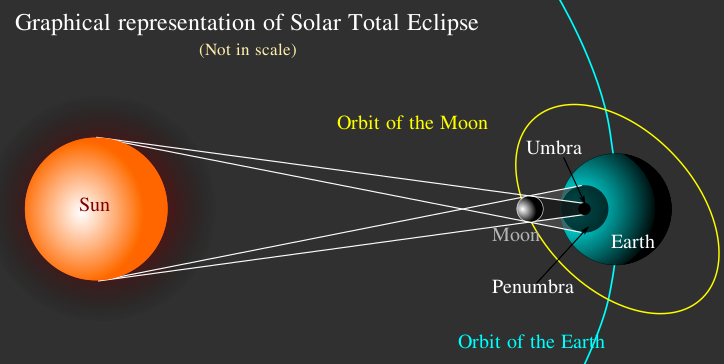
During a solar eclipse which of the following comes in the middle?
A) Sun
B) Moon
C) Earth
D) None of these
Answer
486k+ views
Hint: An eclipse is a natural occurrence. Solar eclipse occurs when the Sun, Moon and Earth are aligned. This phenomenon happens when a portion of the Earth is engulfed in a shadow cast by the Moon which fully or partially blocks sunlight.
Complete answer:
If the Moon were in a perfectly circular orbit, slightly near to the Earth, and in the same orbital plane, there would be total solar eclipses every new moon.
Option A) Sun: This option is incorrect as when one observes from the Earth, a solar eclipse occurs when the Moon passes between the Sun and Earth, and the Moon fully or partially blocks the Sun. Thus, the Sun comes first during solar eclipse.
Option B) Moon: This option is correct as when one observes from the Earth, a solar eclipse occurs when the Moon passes between the Sun and Earth, and the Moon fully or partially blocks the Sun. This event happens only at a new moon when the Sun and the Moon are in conjunction as seen from Earth in an alignment.
Option C) Earth: This option is incorrect as when one observes from the Earth, a solar eclipse occurs when the Moon passes between the Sun and Earth, and the Moon fully or partially blocks the Sun. Thus, the Earth comes at last during a solar eclipse.
Option D) None of these: The is option is incorrect as when one observes from the Earth, a solar eclipse occurs when the Moon passes between the Sun and Earth, and the Moon fully or partially blocks the Sun. Thus, the moon comes in the middle during solar eclipse which makes this option invalid.

Therefore the correct answer is option ‘B’.
Note: An eclipse is a galactic occasion that happens when a cosmic item or spacecraft is briefly clouded, by passing into the shadow of another body or by having another body pass among it and the observer. This arrangement of three celestial objects is known as a syzygy. Aside from syzygy, the term eclipse is additionally utilized when a space shuttle arrives at a position where it can notice two celestial bodies so aligned. An eclipse is the consequence of either an occultation (totally covered up) or a transit (halfway covered up).
There are three principle types of solar eclipses:
- Total solar eclipse: A total solar eclipse is visible from a small region on Earth.
- Partial solar eclipse: This happens when the Sun, Moon and Earth are not actually aligned.
- Annular solar eclipse: An annular eclipse occurs when the Moon is farthest from Earth.
Complete answer:
If the Moon were in a perfectly circular orbit, slightly near to the Earth, and in the same orbital plane, there would be total solar eclipses every new moon.
Option A) Sun: This option is incorrect as when one observes from the Earth, a solar eclipse occurs when the Moon passes between the Sun and Earth, and the Moon fully or partially blocks the Sun. Thus, the Sun comes first during solar eclipse.
Option B) Moon: This option is correct as when one observes from the Earth, a solar eclipse occurs when the Moon passes between the Sun and Earth, and the Moon fully or partially blocks the Sun. This event happens only at a new moon when the Sun and the Moon are in conjunction as seen from Earth in an alignment.
Option C) Earth: This option is incorrect as when one observes from the Earth, a solar eclipse occurs when the Moon passes between the Sun and Earth, and the Moon fully or partially blocks the Sun. Thus, the Earth comes at last during a solar eclipse.
Option D) None of these: The is option is incorrect as when one observes from the Earth, a solar eclipse occurs when the Moon passes between the Sun and Earth, and the Moon fully or partially blocks the Sun. Thus, the moon comes in the middle during solar eclipse which makes this option invalid.

Therefore the correct answer is option ‘B’.
Note: An eclipse is a galactic occasion that happens when a cosmic item or spacecraft is briefly clouded, by passing into the shadow of another body or by having another body pass among it and the observer. This arrangement of three celestial objects is known as a syzygy. Aside from syzygy, the term eclipse is additionally utilized when a space shuttle arrives at a position where it can notice two celestial bodies so aligned. An eclipse is the consequence of either an occultation (totally covered up) or a transit (halfway covered up).
There are three principle types of solar eclipses:
- Total solar eclipse: A total solar eclipse is visible from a small region on Earth.
- Partial solar eclipse: This happens when the Sun, Moon and Earth are not actually aligned.
- Annular solar eclipse: An annular eclipse occurs when the Moon is farthest from Earth.
Recently Updated Pages
Master Class 12 Business Studies: Engaging Questions & Answers for Success

Master Class 12 Economics: Engaging Questions & Answers for Success

Master Class 12 English: Engaging Questions & Answers for Success

Master Class 12 Maths: Engaging Questions & Answers for Success

Master Class 12 Social Science: Engaging Questions & Answers for Success

Master Class 12 Chemistry: Engaging Questions & Answers for Success

Trending doubts
Give 10 examples for herbs , shrubs , climbers , creepers

Four bells toll together at 900am They toll after 7811 class 6 maths CBSE

What is BLO What is the full form of BLO class 8 social science CBSE

What is meant by exothermic and endothermic reactions class 11 chemistry CBSE

Which places in India experience sunrise first and class 9 social science CBSE

Which animal has three hearts class 11 biology CBSE





